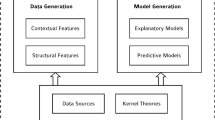Abstract
Interactive voice response (IVR) systems represent a convergence of automated computerized interview techniques with telephone survey research. This convergence affords unparalleled opportunities for conducting longitudinal behavioral research. Our experiences, after several years of conducting multiple IVR studies investigating the circumstances and consequences of daily alcohol use patterns, continues to generate excitement regarding the research potential of this methodology. This article discusses design and implementation considerations, and potential pitfalls, for others interested in conducting this type of research. The discussion is structured around: (1) IVR script development, (2) programming implementation issues, (3) research administration of longitudinal IVR studies, and (4) database management and hardware configuration issues: The future of IVR research and further integration of developed and emerging technologies are also discussed.
Similar content being viewed by others
References
De Leeuw, E.D. and Van der Zouwen, J. (1988). Data quality in telephone and face to face surveys: A comparative meta-analysis. In R.M. Groves, P.P. Biemer, L.E. Lyberg, J.T. Massey, W.L. Nicholls, and J. Waksberg (Eds.),Telephone Survey Methodology. New York: Wiley.
Erdman, H.P., Klein, M.H., Greist, J.H., Skare, S.S., Husted, J.J., Robins, L.N., Helzer, J.E., Goldring, E., Hamburger, M., and Miller, J.P. (1992). A comparison of two computer-administered versions of the NIMH diagnostic interview schedule.Journal of Psychiatric Research, 26(1):85–95.
González, G.M. (1993). A computerized speech recognition telephone application for screening clinical depression. In C. Safran (Ed.), Symposium on Computer Applications in Medical Care. New York: McGraw-Hill.
González, G.M., Spiteri, C.B., and Knowlton, J.P. (1995). An exploratory study using computerized speech recognition for screening depressive symptoms.Computers in Human Behavior, 11(1):85–93.
Greist, J.H., Klein, M.H., and Van Cura, L.J. (1973a). A computer interview for psychiatric patient target symptoms.Archives of General Psychiatry, 29:247–253.
Greist, J.H., Van Cura, L.J., and Kneppreth, N.P. (1973b). A computer interview for emergency room patients.Computers and Biomedical Research, 6:257–265.
Greist, J.H., Gustafson, D.H., Stanss, F.F., Rowse, G.L., Laughren, T.P., and Chiles, J.A. (1973c). A computer interview for suicide-risk prevention.American Journal of Psychiatry, 30(12): 1327–1332.
Greist, J.H. and Klein, M.H. (1980). Computer programs for patients, clinicians, and researchers in psychiatry. In J.B. Sidowski, J.H. Johnson, and T.A. Williams (Eds.),Technology in Mental Health Care Delivery Systems. Norwood, NJ: Ablex, pp. 161–181.
Greist, J.H., Klein, M.H., Erdman, H.P., Bires, J.K., Bass, S.M., Machtinger, P.E., and Kresge, D.G. (1987). Comparison of computer- and interview-administered versions of the diagnostic interview schedule.Hospital and Community Psychiatry, 38(12): 1304–1311.
Kahneman, D. and Tversky, A. (1984). Choices, values, and frames.American Psychologist, 39: 341–350.
Lavrakas, P.J. (1987). Telephone survey methods: Sampling, selection, and supervision.Applied Social Research Methods Series 7. Newbury Park, CA: Sage.
Lemmens, P., Knibbe, R.A., and Tan, F. (1988). Weekly recall and diary estimates of alcohol consumption in a general population survey.Journal of Studies on Alcohol, 49: 131–135.
Lucas, R.W., Mullin, P.J., Luna, C.B.X., and McInroy, D.C. (1977). Psychiatrists and a computer as interrogators of patients with alcohol-related illnesses: A comparison.British Journal of Psychiatry, 131: 160–167.
Mundt, J.C., Perrine, M.W., Searles, J.S., and Walter, D. (1995a). An application of interactive voice response technology to longitudinal studies of daily behavior.Behavior Research Methods, Instruments and Computers, 27(3): 351–357.
Mundt, J.C., Searles, J.S., Perrine, M.W., and Helzer, J.E. (1995b). Cycles of alcohol dependence: Frequency-domain analyses of daily drinking logs for matched alcohol-dependent and nonclinical subjects.Journal of Studies on Alcohol, 56(5): 491–499.
Mundt, J.C., Kelleher, P.F., Perrine, M.W., and Searles, J.S. (in press). Psychological performance assessment via interactive voice response systems.Behavior Research Methods, Instruments and Computers.
Muñoz, R.F., González, G.M., and Starkweather, J. (1995). Automated screening for depression: Toward culturally and linguistically appropriate uses of computerized speech recognition.Hispanic Journal of Behavioral Sciences, 17(2): 194–208.
Nicholls, W.L. and Groves, R.M. (1986). The status of computerassisted telephone interviewing: Introduction and impact on cost and timeliness of survey data.Journal of Official Statistics, 2(2): 93–115.
Noyes, J.M., Haigh, R., and Starr, A.E. (1989). Automatic speech recognition for disabled people.Applied Ergonomics, 20(4): 293–298.
Perrine, M.W., Searles, J.S., Mundt, J.C., and Arce-Quiñones, W.M. (1993).The Feasibility of Collecting Self-reported Daily Drinking Data by Telephone: A Pilot Study. Unpublished manuscript.
Perrine, M.W., Mundt, J.C., Searles, J.S., and Lester, L.S. (1995). Validation of daily self-reported alcohol consumption using interactive voice response (IVR) technology.Journal of Studies on Alcohol, 56(5): 487–490.
Richards, J.S., Fine, P.R., Wilson, T.L., and Rogers, J.T. (1983). A voice-operated method for administering the MMPI.Journal of Personality Assessment, 47(2): 167–170.
Schumacher, R.M., Hardzinski, M.L., and Schwartz, A.L. (1995). Increasing the usability of interactive voice response systems: Research and guidelines for phone-based interfaces.Human Factors, 37(2): 251–264.
Searles, J.S., Perrine, M.W., Mundt, J.C., and Helzer, J.E. (1995). Self-report of drinking by touch-tone telephone: Extending the limits of reliable daily contact.Journal of Studies on Alcohol, 56(4): 375–382.
Seilhamer, R.A., Jacob, T., and Dunn, M.J. (1993). The impact of alcohol consumption on parent-child relationships in families of alcoholics.Journal of Studies on Alcohol, 54(2): 189–198.
Sobell, L.C., Cellucci, T., Nirenberg, T.D., and Sobell, M.B. (1982). Do quantity-frequency data underestimate drinking-related health risks?American Journal of Public Health, 72(8): 823–828.
Sobell, L.C. and Sobell, M.B. (1992). Timeline follow-back: A technique for assessing self-reported alcohol consumption. In R.Z. Litten and J.P. Allen (Eds.),Measuring Alcohol Consumption: Psychosocial and Biochemical Methods. Totowa, NJ: Humana Press, pp. 41–72.
Sorrell, S.P., Greist, J.H., Klein, M.H., Johnson, J.H., and Harris,W.G. (1982). Enhancement of adherence to tricyclic antidepressants by computerized supervision.Behavior Research Methods and Instrumentation, 14(2): 176–180.
Author information
Authors and Affiliations
Rights and permissions
About this article
Cite this article
Mundt, J.C., Searles, J.S., Perrine, M.W. et al. Conducting longitudinal studies of behavior using interactive voice response technology. Int J Speech Technol 2, 21–31 (1997). https://doi.org/10.1007/BF02539820
Received:
Accepted:
Issue Date:
DOI: https://doi.org/10.1007/BF02539820




